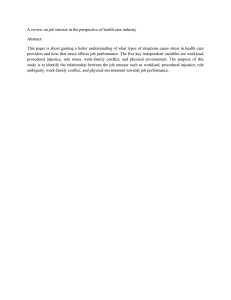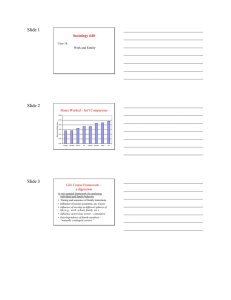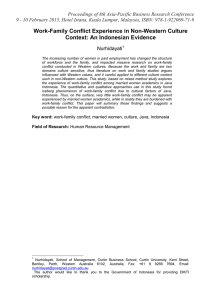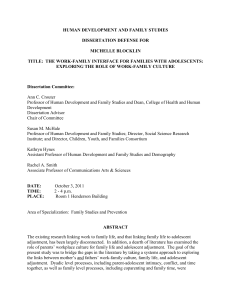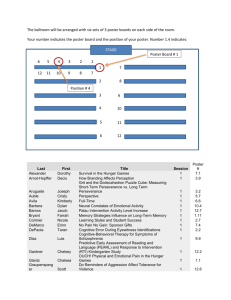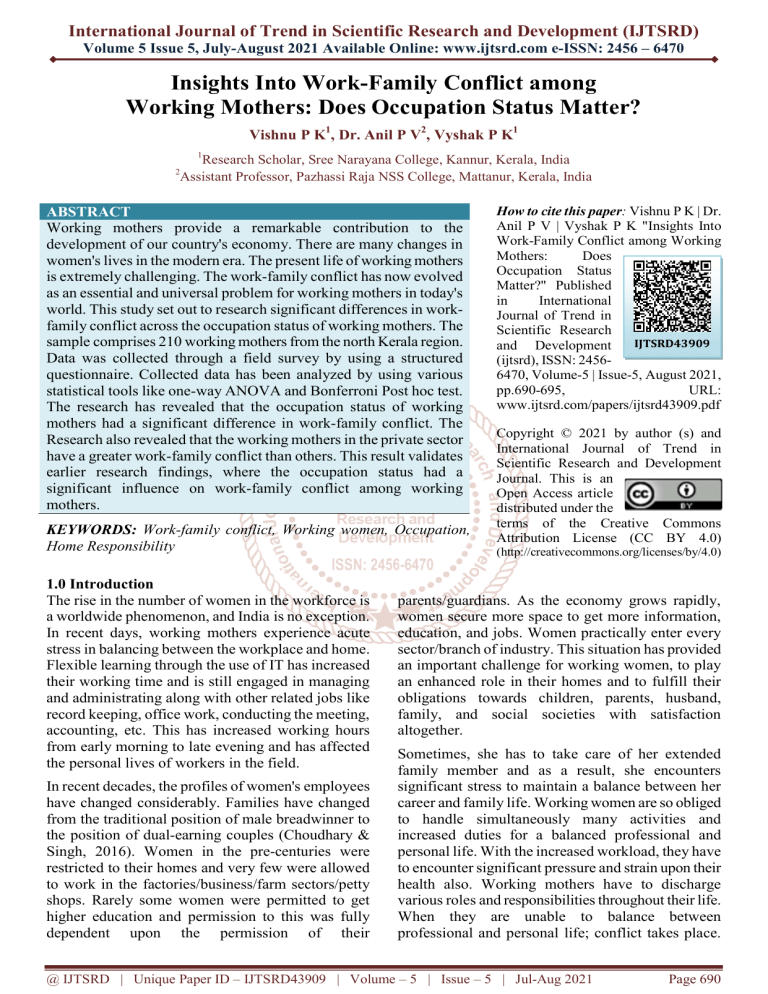
International Journal of Trend in Scientific Research and Development (IJTSRD)
Volume 5 Issue 5, July-August 2021 Available Online: www.ijtsrd.com e-ISSN: 2456 – 6470
Insights Into Work-Family Conflict among
Working Mothers: Does Occupation Status Matter?
Vishnu P K1, Dr. Anil P V2, Vyshak P K1
1
Research Scholar, Sree Narayana College, Kannur, Kerala, India
Assistant Professor, Pazhassi Raja NSS College, Mattanur, Kerala, India
2
ABSTRACT
Working mothers provide a remarkable contribution to the
development of our country's economy. There are many changes in
women's lives in the modern era. The present life of working mothers
is extremely challenging. The work-family conflict has now evolved
as an essential and universal problem for working mothers in today's
world. This study set out to research significant differences in workfamily conflict across the occupation status of working mothers. The
sample comprises 210 working mothers from the north Kerala region.
Data was collected through a field survey by using a structured
questionnaire. Collected data has been analyzed by using various
statistical tools like one-way ANOVA and Bonferroni Post hoc test.
The research has revealed that the occupation status of working
mothers had a significant difference in work-family conflict. The
Research also revealed that the working mothers in the private sector
have a greater work-family conflict than others. This result validates
earlier research findings, where the occupation status had a
significant influence on work-family conflict among working
mothers.
KEYWORDS: Work-family conflict, Working women, Occupation,
Home Responsibility
1.0 Introduction
The rise in the number of women in the workforce is
a worldwide phenomenon, and India is no exception.
In recent days, working mothers experience acute
stress in balancing between the workplace and home.
Flexible learning through the use of IT has increased
their working time and is still engaged in managing
and administrating along with other related jobs like
record keeping, office work, conducting the meeting,
accounting, etc. This has increased working hours
from early morning to late evening and has affected
the personal lives of workers in the field.
In recent decades, the profiles of women's employees
have changed considerably. Families have changed
from the traditional position of male breadwinner to
the position of dual-earning couples (Choudhary &
Singh, 2016). Women in the pre-centuries were
restricted to their homes and very few were allowed
to work in the factories/business/farm sectors/petty
shops. Rarely some women were permitted to get
higher education and permission to this was fully
dependent upon the permission of their
How to cite this paper: Vishnu P K | Dr.
Anil P V | Vyshak P K "Insights Into
Work-Family Conflict among Working
Mothers:
Does
Occupation Status
Matter?" Published
in
International
Journal of Trend in
Scientific Research
IJTSRD43909
and Development
(ijtsrd), ISSN: 24566470, Volume-5 | Issue-5, August 2021,
pp.690-695,
URL:
www.ijtsrd.com/papers/ijtsrd43909.pdf
Copyright © 2021 by author (s) and
International Journal of Trend in
Scientific Research and Development
Journal. This is an
Open Access article
distributed under the
terms of the Creative Commons
Attribution License (CC BY 4.0)
(http://creativecommons.org/licenses/by/4.0)
parents/guardians. As the economy grows rapidly,
women secure more space to get more information,
education, and jobs. Women practically enter every
sector/branch of industry. This situation has provided
an important challenge for working women, to play
an enhanced role in their homes and to fulfill their
obligations towards children, parents, husband,
family, and social societies with satisfaction
altogether.
Sometimes, she has to take care of her extended
family member and as a result, she encounters
significant stress to maintain a balance between her
career and family life. Working women are so obliged
to handle simultaneously many activities and
increased duties for a balanced professional and
personal life. With the increased workload, they have
to encounter significant pressure and strain upon their
health also. Working mothers have to discharge
various roles and responsibilities throughout their life.
When they are unable to balance between
professional and personal life; conflict takes place.
@ IJTSRD | Unique Paper ID – IJTSRD43909 | Volume – 5 | Issue – 5 | Jul-Aug 2021
Page 690
International Journal of Trend in Scientific Research and Development @ www.ijtsrd.com eISSN: 2456-6470
Hence, it is a need of the situation of the working
mothers to maintain a balance between professional
and personal life.
1.1
Work-Family Conflict – A literature
Review
The researcher has gone through previous studies of
the subject matter before resuming the objectives and
was presented as the literature review. Many
researchers and theories focused on the work family
conflicts. The influence of work-family conflict on
organisational and personal well-being has been
explored in the literature (Ford et al., 2007; Kossek &
Ozeki, 1998). As a result of the productive family
patterns, Adult human lives have been directed to
fulfil the two most essential responsibilities, namely
work and family roles. The men and women have to
perform dual roles as workers and as family members
(Karimi et al., 2012). Each of these categories has its
own set of roles and responsibilities. The literature
shows that these work and family roles interact in a
variety of ways (Zhou et al., 2020).
Work-family conflict is a psychological condition
characterised by an imbalance of work and home life.
Job burnout, dissatisfaction, work stress, long
working hours, and role conflict are the most
significant factors that lead to work-family conflict.
(Bakker et al., 2005; Ford et al., 2007; Kossek &
Ozeki, 1998; Spector et al., 2004). Workplace
challenges such as job pressure and stressful events
(Cartwright & Pappas, 2008) may physically and
emotionally exhaust an individual to the point that
work-family conflict arises (Baeriswyl et al., 2016;
Frone et al., 1997).
The two-way model of work-family conflict
demonstrates that workplace stress fctors such as a
lack of autonomy or an excessive workload affect the
“work” side of the balance, whereas family stress
factors such as misbehaving kids or excessively
dependent parents harm the “family” side (Liu et al.,
2019). Work/family conflict is bidirectional, which
means that work roles can clash with roles and
obligations in the family domain, and family roles can
conflict with work roles. The bidirectionality of
work/family conflict is supported by research, which
also suggests that work-to-family and family-to-work
conflict may have different origins and outcomes
(Mesmer-Magnus & Viswesvaran, 2005).
In a person's life, work and family are two crucial
domains. Both home and work duties have a direct
impact on each other (Patel et al., 2006; SánchezVidal et al., 2019). The study of the negative effects
of work-family conflict has received a significant
amount of organisational attention. (Turan et al.,
2021) The study's primary goal is to look at the role
of burnout in the influence of work-family conflicts
(WFC) on job satisfaction among important
participants in the maritime sector. According to the
findings, Burnout has a minor mediation impact on
work satisfaction, (Sprung, 2021) to fill a gap in the
research by looking at personal and global economic
stress as predictors of family distress and work-family
conflict in a population of farm spouses. Examining
the work-family interface of farm couples, economic
stress is an essential factor. Furthermore, family
distress and work-family conflict were more affected
by personal economic stress than global economic
stress. By gaining a deeper knowledge of the familial
mechanisms through which farm spouses may be
affected by economic stress.
2.0 Statement of the problem
In families and workplaces, women play a significant
role. Women are deeply entrenched in their social life
in the role of homemakers and caretakers. In the
modern era, women's lives are now changing and the
life of working mothers are highly stressful. Working
women occupy a space equivalent to males and are
becoming more aspiring and professional. Other
elements of their life are being ignored by working
women and losing quality time with their children and
families, relaxation time, and also time for their
hobbies. Working mothers are more stressed than
males as they have to work from early morning to late
night to satisfy the daily requirements of their family
members. For women employees, work occupies an
important place in their lives, the status of quality of
work life affects not only their physical but also
social, psychological, and spiritual wellbeing.
For more than five decades, substantial study has
been conducted on the work-family conflict of
employees in many areas. however, little attention has
been paid to the occupation perspective on workfamily conflict. Since employees of different
occupation status vary in conflict between work and
family matters. The factors which are associated with
high or expected levels of work-family conflict for
private employee perhaps may or may not be the
same for public employees. Therefore, The present
study was designed as an investigation of the
relationship between family-work conflict and
occupation status of working mothers
3.0 Research Objectives and Hypothesis
This study is focused on investigating the workfamily conflicts and the nature of these conflicts
among working mothers in the state of Kerala from
the perspective of their occupation status.
@ IJTSRD | Unique Paper ID – IJTSRD43909 | Volume – 5 | Issue – 5 | Jul-Aug 2021
Page 691
International Journal of Trend in Scientific Research and Development @ www.ijtsrd.com eISSN: 2456-6470
Following research questions guided this study.
1.
What is the nature of work-family conflicts
among working mothers?
2.
Does occupation status of the working mothers
is really a matter in work-family conflict ?
In alignment with research questions, the primary
objectives of the present study are
1. To measure the degree of work-family conflict
among women employees
2. To determine the significant difference in workfamily conflict across different occupation status
of working women
The following hypothesis has been formulated in
accordance with the objectives of the study.
H0: The degree of work-family conflict has no
differences across the occupation status of working
mothers
2014). There were two components to this
questionnaire. The purpose of the first section of the
questionnaire was to collect demographic information
from the participants. The second section of the
questionnaire consists of ten items that are rated on a
five-point scale in order to obtain information about
work-family conflict.
The respondents were selected randomly from the
north Kerala region. The questionnaire was
distributed to 241 working mothers, who were
available on days of data collection. Of these 241
teachers, 210 returned their questionnaires. So the
return response rate of the tool was 87%. As a result,
all these 210 working mothers in north Kerala were
taken as a sample for this study.
Advanced decisions were made when formulating
objectives, designing method, selecting the sample for
data collection. Data analysis and reporting were
planned with expertise's approval and data analysis
was done using the SPSS, the relevant statistic tools
such as ANOVA, Post hoc analysis were used.
4.0 Research methodology
The purpose of the study is to examine the
5.0 Results and discussion
relationship between work-family conflict and
This study included two stages in its data analysis
occupation status of working mothers. For this, a
procedure. A descriptive analysis describing the
descriptive research approach was used. The study
nature of work-family conflicts as perceived by
was conducted on a sample 210 of full-time working
working mothers in the first step. The second stage
mothers in north Kerala. The data was collected
included hypothesis testing with ANOVA.
through a structured questionnaire. This questionnaire
was initially developed by (Erdamar & Demirel,
The Nature of Work-Family Conflicts as Perceived by Working Mothers
The results of the nature of the work-family conflicts as perceived by working mothers are presented in Table 1.
Table 1: The nature of work-family conflicts as perceived by teachers
Statements
Mean
Tasks/responsibilities at work – unable to spend time with family.
4.24
Fatigue at work – creates difficulties in home responsibilities.
3.79
Workplace duties cause tiredness while performing home tasks.
3.89
Workplace tasks result in postponing house tasks.
3.36
Workplace tasks reduce efforts for home responsibilities.
3.75
Continuously think about workplace problems, affecting the family.
4.06
Workplace duties/responsibilities get ahead of family.
3.89
Fatigue at work – decreased tolerance towards family.
Workplace problems cause stress and nervousness at home.
Problems/troubles at home affect professional life.
Overall
Source: Primary data
3.74
4.01
3.56
3.82
SD
1.12
.95
.76
.89
.94
.86
.72
.83
.76
.73
.85
Table 1 clearly shows that the overall mean values of statements about work-family conflicts is 3.82, and range
from 2.36 to 4.24. All these values show that working mothers agreed with all statements and believe that their
workplace activities affect their family role. They truthfully say that their work responsibilities and tasks
prevent them from spending time with their families. Working mothers also view that they continuously think
about workplace problems which affect affecting the family. They Further perceived that workplace duties cause
tiredness while performing home tasks.
@ IJTSRD | Unique Paper ID – IJTSRD43909 | Volume – 5 | Issue – 5 | Jul-Aug 2021
Page 692
International Journal of Trend in Scientific Research and Development @ www.ijtsrd.com eISSN: 2456-6470
Work-family conflict and Occupation status
The descriptive statistics of occupation status of the working mothers is presented in table 2
Table 2. Descriptive Statistics
N
Public sector
48
Private sector
42
Professionals
33
Business
44
Self employed 43
Total
210
Source: Primary data
Mean
Std.
Deviation
Std.
Error
42.6875
44.7143
38.7879
35.1818
33.7209
39.0714
3.67369
3.45201
3.73127
2.83067
3.34753
5.46758
.53025
.53266
.64953
.42674
.51049
.37730
95% Confidence
Interval for Mean
Lower
Upper
Bound
Bound
41.6208 43.7542
43.6386 45.7900
37.4648 40.1109
34.3212 36.0424
32.6907 34.7511
38.3276 39.8152
Minimum Maximum
35.00
36.00
31.00
28.00
25.00
25.00
49.00
49.00
45.00
40.00
39.00
49.00
The table 2 provides some very useful descriptive statistics, including the mean, standard deviation and 95%
confidence intervals for the dependent variable for each separate group (Public sector, Private sector,
Professional, Business and Self-employed), as well as when all groups are combined. This table shows the
summary statistics for the 5 groups, the mean scores are 42.6875, 44.7143, 38.7879, 35.1818, and 33.7209 for
public sector, private sector, professional, business and self-employed respectively. Respondents belong to the
self-employed category have the smallest mean compared to the other groups. An analysis of variance was
performed to examine the relationship between work-family conflict and occupational status and the result was
presented in table 4.
H0: The degree of work-family conflict has no differences across the occupation status of the respondents
Table 3 Test of Homogeneity of Variances
Levene Statistic df1 df2 Sig.
1.483
4 205 .208
Source: Primary data Significant at 0.05 level
A requirement for the ANOVA test is that the variances of each comparison group are equal. This is tested using
the Levene statistic and the result is presented in table 2. The significance value of the Levene statistic based on
a comparison of medians is .208 which is greater than .05. This is not a significant result, which means the
requirement of homogeneity of variance has been met, and the ANOVA test can be considered to be robust.
Table 4 ANOVA Test Result
Sum of Squares df Mean Square
Between Groups
3864.333
4
966.083
Within Groups
2383.596 205
11.627
Total
6247.929 209
Source: Primary data Significant at 0.05 level
F
83.088
Sig.
.000
The table 3 shows the output of the ANOVA analysis and whether there is a statistically significant difference
between work-family conflict and occupation status. The result shows that there was a statistically significant
difference between groups as determined by one-way (F (4,205) = 83.088, p=.000). The significance value is
0.000 (i.e., p = .000), which is below 0.05. and therefore, reject the null hypothesis. Hence, the results conclude
that there is a statistically significant difference in the between work-family conflict and occupation status.
@ IJTSRD | Unique Paper ID – IJTSRD43909 | Volume – 5 | Issue – 5 | Jul-Aug 2021
Page 693
International Journal of Trend in Scientific Research and Development @ www.ijtsrd.com eISSN: 2456-6470
Table 5 Bonferroni Correction Result
(I) Occupation (J) Occupation Mean Difference (I-J) Std. Error
Public sector
Private sector
3.60606*
.78524
*
Professionals
5.06695
.78914
Sig.
.000
.000
Business
-5.92641*
.79321
.000
Self employed
-3.89962*
.77109
.000
*
.78524
.73120
.73559
.71168
.78914
.73120
.73976
.71599
.79321
.73559
.73976
.72047
.77109
.71168
.71599
.72047
.000
.000
.000
.000
.000
.000
.000
.000
.000
.000
.000
.094
.000
.000
.000
.094
Private sector
Public sector
-3.60606
Professionals
1.46089*
Business
-9.53247*
Self employed
-7.50568*
Professionals
Public sector
-5.06695*
Private sector
-1.46089*
Business
-10.99336*
Self employed
-8.96657*
Business
Public sector
5.92641*
Private sector
9.53247*
Professionals
10.99336*
Self employed
2.02679
Self employed
Public sector
3.89962*
Private sector
7.50568*
Professionals
8.96657*
Business
-2.02679
Source: Primary data Significant at 0.05 level
From the results so far, there are statistically significant differences between the groups as a whole. The table 4
shows which groups differed from each other. The Bonferroni post hoc test was employed to identify which
groups differed from each other. The Bonferroni correction analysis shows that it is only the mean difference
between the business and self-employed does not reaches significance (.094>0.05). It is showed that the
respondents in the business category was not statistically differ from the respondents of self-employed category.
6.0 Conclusion
The following main conclusions were derived from
the findings in answer to the study questions. First, it
was discovered that working mothers believe that
their workplace tasks cause conflicts or obstacles in
their family roles. This study has been piloted to
quantify the work-family conflict of working mothers
in the current era to determine the significant
difference in work-family conflict across the
occupation status of working mothers. The sample
survey has revealed that there is a significant
difference in work-family conflict across the
occupation status of working mothers. The study also
reveals that working mothers in private sector have a
higher work-family conflict than others. This result
confirms previous research findings, where the
occupation status had a significant influence on
occupation status of working mothers
References
[1] Baeriswyl, S., Krause, A., &Schwaninger, A.
(2016). Emotional exhaustion and job
satisfaction in airport security officers – Work–
Family conflict as mediator in the job
Demands–Resources model. Frontiers in
Psychology,
7:663.
https://doi.org/10.3389/fpsyg.2016.00663
[2]
Bakker, A. B., Demerouti, E., &Euwema, M. C.
(2005). Job resources buffer the impact of job
demands on Burnout. Journal of Occupational
Health
Psychology,
10(2),
170–180.
https://doi.org/10.1037/1076-8998.10.2.170
[3]
Cartwright, S., & Pappas, C. (2008). Emotional
intelligence, its measurement and implications
for the workplace. International Journal of
Management Reviews, 10(2), 149–171.
https://doi.org/10.1111/j.14682370.2007.00220.x
@ IJTSRD | Unique Paper ID – IJTSRD43909 | Volume – 5 | Issue – 5 | Jul-Aug 2021
Page 694
International Journal of Trend in Scientific Research and Development @ www.ijtsrd.com eISSN: 2456-6470
[4]
Choudhary, N., & Singh, N. K. (2016). Workfamily & family-work conflict of dual-earner
couples: A study on officers of defence CPSE
in bangalore. OPUS: HR Journal, 7(1), 25–50.
https://doi.org/10.21863/opus/2016.7.1.014
[5]
Erdamar, G., &Demirel, H. (2014).
Investigation of work-family, family-work
conflict of the teachers. Procedia - Social and
Behavioral Sciences, 116, 4919–4924.
https://doi.org/10.1016/j.sbspro.2014.01.1050
[6]
[7]
[8]
[9]
Ford, M. T., Heinen, B. A., &Langkamer, K. L.
(2007). Work and family satisfaction and
conflict: A meta-analysis of cross-domain
relations. Journal of Applied Psychology, 92(1),
57–80.
https://doi.org/10.1037/00219010.92.1.57
Frone, M. R., Yardley, J. K., & Markel, K. S.
(1997). Developing and Testing an Integrative
Model of the Work–Family Interface. Journal
of Vocational Behavior, 50(2), 145–167.
https://doi.org/10.1006/jvbe.1996.1577
K. HariPriya, K. H., &Dr. N. Brindha, D. N. B.
(2012). Influence of Work Related Stress on
Work-Family Conflict: A Study Among
Marketing Professionals in Coimbatore District.
Paripex - Indian Journal Of Research, 3(7), 1–
3.
https://doi.org/10.15373/22501991/july2014/40
Karimi, Q., Jomehri, F., Asadzade, H.,
&Sohrabi, F. (2012). Consequences of conflict
between work and family among Iranian female
teachers. Journal of Basic Applied Science
Research, 2(2), 1869–1875.
[10]
Kossek, E., & Ozeki, C. (1998). Work-family
conflict, policies, and the job-life satisfaction
relationship: A review and directions for
organizational behavior-human resources
research. Journal of Applied Psychology, 83(2),
139–149.
https://doi.org/10.1037/00219010.83.2.139
[11]
Liu, T., Zeng, X., Chen, M., & Lan, T. (2019).
The harder you work, the higher your
satisfaction with life? The influence of police
work engagement on life satisfaction: A
moderated mediation model. Frontiers in
Psychology,
10:826.
https://doi.org/10.3389/fpsyg.2019.00826
[12]
Mesmer-Magnus, J. R., &Viswesvaran, C.
(2005). Convergence between measures of
work-to-family and family-to-work conflict: A
meta-analytic examination. Journal of
Vocational Behavior, 67(2), 215–232.
https://doi.org/10.1016/j.jvb.2004.05.004
[13]
Patel, C. J., Govender, V., Paruk, Z.,
&Ramgoon, S. (2006). Working mothers:
Family-work conflict, job performance and
family/work variables. SA Journal of Industrial
Psychology,
32(2).
https://doi.org/10.4102/sajip.v32i2.238
[14]
Sánchez-Vidal, M. E., Cegarra-Leiva, D., &
Cross, C. (2019). Gender differences in interrole conflict in Spain. Employee Relations: The
International Journal, 42(2), 437–452.
https://doi.org/10.1108/er-02-2019-0120
[15]
Spector, P. E., Cooper, C. L., Poelmans, S.,
Allen, T. D., O’Driscoll, M., Sanchez, J. I., Siu,
O. L., Dewe, P., Hart, P., & Lu, L. (2004). A
cross-national comparative study of workfamily stressors, working hours, and wellbeing: China and Latin America versus the
Anglo world. Personnel Psychology, 57(1),
119–142.
https://doi.org/10.1111/j.17446570.2004.tb02486.x
[16]
Sprung, J. M. (2021). Economic Stress, Family
Distress, and Work-Family Conflict among
Farm Couples. Journal of Agromedicine.
Published.
https://doi.org/10.1080/1059924x.2021.194441
7
[17]
Turan, E., Bozkurt, S., ÇElebi, U. B., &Ekinci,
S. (2021). The role of burnout in the effect of
work-family conflicts on job satisfaction: A
research for key players in the maritime
industry. Maritime Policy & Management, 1–
14.
https://doi.org/10.1080/03088839.2021.195085
9
[18]
Zhou, S., Li, X., & Gao, B. (2020).
Family/friends support, work-family conflict,
organizational commitment, and turnover
intention in young preschool teachers in China:
A serial mediation model. Children and Youth
Services
Review,
113(1),
104997.
https://doi.org/10.1016/j.childyouth.2020.10499
7
@ IJTSRD | Unique Paper ID – IJTSRD43909 | Volume – 5 | Issue – 5 | Jul-Aug 2021
Page 695

